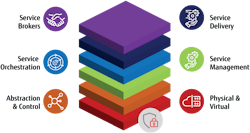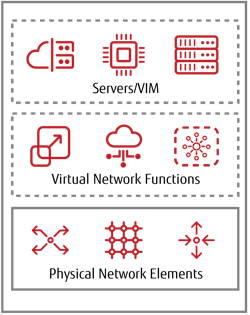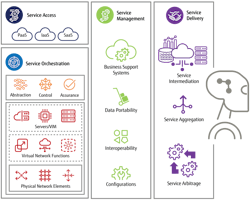How Does Network Transformation Drive Incremental Revenue?
As customer expectations for digital experiences continue to grow, communications service providers (CSPs) are being pressured to deliver higher speeds, better performance, and optimized quality of service. Yet at the same time, competitive pressure also is ramping up with disruptive, digital-first operators entering the market and challenging the status quo with radically new offers.
Today’s CSPs are painfully aware that they need to transform legacy networks to enable new revenue sources. They know they need agility to meet customer expectations and fend off digital-first competitors. However, for a million good reasons, building and executing this transformation strategy is a challenging prospect that is often neglected or delayed.
Capture customer value
The advanced capabilities of digital transformation allow delivery of unique services for both business and residential customers. New cloud-native operations and business support systems enable highly individualized services running on cloud-based infrastructure, ushering in a new age of agility and scalability. For some CSPs, the evolution to 5G offers an opportunity to implement these cloud-based technologies to deliver positive connected experiences from the edge to the network core. For others, the key is to focus on network improvements that can be deployed quickly, creating the most customer value by monetizing services that align with market trends right now.
Implementing cloud-capable network solutions strategically and methodically provides significant opportunity for differentiation, including seamless connectivity, productivity innovations, data-driven insights, and personalized customer engagements. Connecting legacy network elements to new digital infrastructure improves energy efficiency and reduces carbon footprint, while extending the life of existing systems.
Yet digital transformation is about much more than replacing physical hardware with virtualized network functions. The underlying software and services must be interoperable and as flexible as possible, which means incorporating open, standardized application programming interfaces (APIs). Moreover, intelligence, analytics, and automation need to be leveraged to their fullest to develop competitive advantages.
Analyze your architecture
Maintaining a balance between an optimized customer experience and profitability is a fine line to walk, requiring network architecture that delivers reliable and personalized services without sacrificing return on investment (ROI). The first step on the road to transformation is to conduct a detailed analysis of existing systems and architectures, services, and operational goals in the context of the current market environment. This analysis enables gaps to be identified so that relevant technologies can be deployed.
Evaluating the mix of products and customized services needed to meet customer needs can help define a robust digital infrastructure roadmap. For example, what are the macroeconomic and regulatory factors affecting the business? What are the most significant revenue drivers? What is—and is not— profitable? Are critical partner relationships valued and nurtured? What defines the typical customer experience? Are supporting processes ad hoc, or repeatable and extendable?
An essential part of this evaluation is to understand which applications work best in public, private, and hybrid clouds. It’s important to remember, however, that today’s digital infrastructure must deploy both legacy and cloud-native applications for the foreseeable future. Recognizing this need for hybrid infrastructure necessitates a big-picture roadmap to achieve cloudification. Fortunately, cloud-capable technologies offer the flexibility to revise that roadmap when unforeseen factors come into play.
Build a plan
When creating the network baseline, be sure to keep the goal of an elastic infrastructure top of mind to ensure that demanding workloads get the quality of service they need. While the point of cloudification is to achieve maximum efficiency, the best approach is to be highly selective about cloud-capable technology initiatives. Streamlined, cloud-capable processes and systems enable the business to take advantage of market opportunities as they arise, whereas moving "old" problems to the cloud won't necessarily generate efficiencies or cost savings for the business.
With a baseline plan in hand, the next step is to identify compatible digital infrastructure elements (Figure 1). Hybrid digital infrastructure needs control and orchestration to be on the network edge or in centralized data centers that are capable of managing virtual resource pools, virtual network elements, and physical network elements. Identifying a cloud-capable control, orchestration, and intelligence platform that spans a healthy mix of private and public clouds is critical, along with lifecycle management tools and templates that can be reused across the network cloud. Over time, the organization will gain a centralized and growing repository of service lifecycle templates and use cases that can be choreographed with automation, continuously optimizing the network and improving performance.
Consider which core systems or functions are best suited to cloud capabilities. For example, some OSS systems might need to remain in the private cloud, while BSS systems can be migrated to the public cloud and delivered as a service. This enables a gradual migration, delivering new, cloud-native applications and services in the public cloud, while keeping legacy applications in the private cloud. It’s important to note that the private cloud is more flexible in meeting unique hosting needs than the public cloud.
It may sound obvious, but once a transformation strategy is approved, it's crucial that the strategy is well socialized and accepted throughout the organization. The most successful transformation initiatives outline the purpose, set the timelines, and invite collaboration, connecting incentives to real outcomes.
Virtualize the infrastructure
Virtualization is the catalyst that drives digital transformation, laying the groundwork for a broader cloud strategy that includes provisioning network resources with modern architectures, open frameworks, and standard models (Figure 2). Virtualization and the cloud are similar in that they both abstract, pool, and share scalable resources across environments — virtualization uses a single physical system, whereas clouds use a network.
The resulting digital infrastructure allows CSPs to quickly move applications and traffic to platforms and locations that make the most financial or operational sense. But no matter what technology is deployed in the cloud, the idea is the same: abstract resources and allocate them to centralized pools that deliver dynamic scale and capacity, enabling greater network flexibility and scalability.
Network virtualization also enables the control plane to be separated from the data plane, allowing developers and network operations broader access to more network elements, so that services can be activated and managed based on dynamic traffic needs. Virtualizing path computation generates even more flexibility, offering the best traffic route and fast recovery from service disruptions. Additional operational benefits and cost savings can be achieved through open, disaggregated network elements, third-party access to proprietary systems, and element management consolidation.
Embrace cloudification
So, how does "virtualization-ready" differ from a "cloud-ready” approach? While some legacy applications and databases don’t lend themselves to cloud migration, they may be candidates for virtualization. Do they employ open standards and APIs? Are they modular and reusable? If the answer is no, virtualization can be beneficial, but the public cloud probably wouldn’t add any value.
Sometimes, it makes more sense to rebuild an application from scratch rather than to migrate it. Determining which is the better option depends on several factors. Will there be fluctuating workloads that require high-scale environments? Is there a hard deadline? Are there intensive compute demands? Does data need to be normalized from a proprietary system? Is a significant investment in hardware required? If the answer to any of these is yes, cloud-native development may be the best way to go.
Today’s network operations centers (NOCs) can use cloud-capable technologies to manage growing network complexity more effectively. The real benefits of digital infrastructure are maximized by securing and automating repetitive tasks and designing self-healing systems that proactively recover from unexpected events and failures. With this level of network automation, NOCs can control, orchestrate, and manage infrastructure at scale, delivering more secure applications and microservices inside the network perimeter while solving problems faster and with greater operational transparency.
Spark network intelligence
Historically, the quest to improve quality of experience (QoE) involved multiple departments distilling customer reports into actions that took days, weeks, or even months to address. Infusing the network with digital intelligence eliminates those constraints, turning information into valuable customer data and insights that optimize workflows. The cloud-capable network plays a significant role in improving QoE and customer retention by supporting end-to-end seamless connectivity, speed, resilience, and widespread on-demand connectivity.
Today’s service providers are extending traditional network monitoring into network intelligence, constantly evaluating service performance and the digital infrastructure that powers it (Figure 3). When digital service delivery leverages distributed data, cloud-capable technologies, and machine learning, audience measurement techniques are continuously enhanced. New datasets enable evidence-based analysis and responses, improving business forecasts and providing valuable insights.
Greater visibility into global network topologies, well-understood dependencies between physical and virtual network elements, predictive analytics, and improved tactical decision making combine to transform network operations into an engine for revenue growth as well. Access to more realistic QoE predictions and granular customer preferences enables CSPs to offer more personalized products and services to transform the competitive landscape.
Disrupt the disruptors
As the appetite for more digital options and services continues to grow, CSPs stand to gain a significant competitive advantage by staying ahead of greenfield market disruptors. They can do this by investing in digital-first initiatives that enable increased simplicity, personalization, and interactivity in the customer experience. And those CSPs that achieve true network transformation success will be able to continuously evolve the existing business and partner ecosystems, driving sustainability and building trust through innovation, even as they align revenue growth with real network value.
Rhonda Holloway is director, network automation solution marketing, at Fujitsu Network Communications.
Rhonda Holloway | Director, Network Automation Solution Marketing, Fujitsu Network Communications
Rhonda Holloway is director, network automation solution marketing, at Fujitsu Network Communications.



